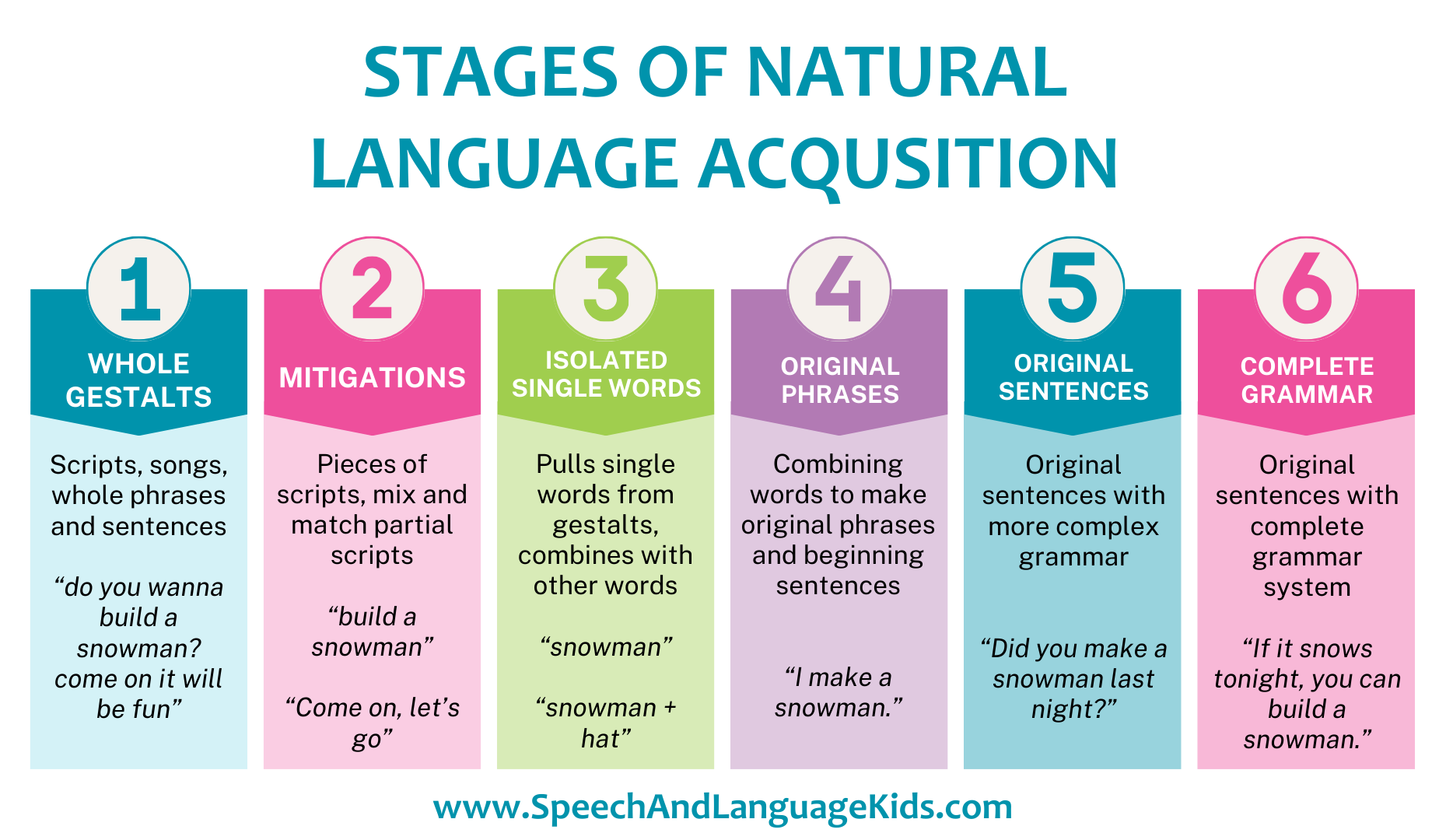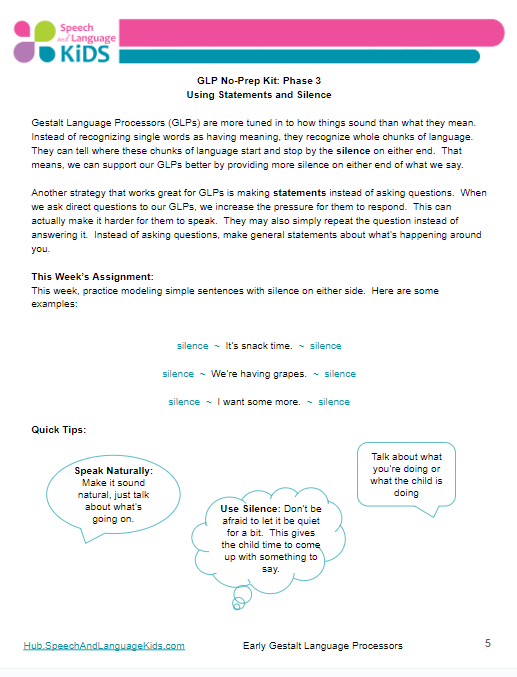Signs that a Child is a Gestalt Language Processor (and How to Help)
Some children learn language one word at a time.
Others learn language in chunks.
They repeat whole sentences or scripts they have heard before.
They use echolalia to communicate with those around them.
These children are called gestalt language processors.
This page provides signs to look for that indicate that a child is a gestalt language processor (using echolalia to communicate). It also includes information about how to help these children thrive!
How do Children Acquire Language?
Did you know that there are two ways that children acquire language?
- Analytic Language Development: Child learns to speak one word at a time. When they have mastered single words, they eventually start combining 2+ words together and utterances grow progressively longer and more complex.
- Gestalt Language Development: Child begins by speaking in whole phrases, sentences, or scripts first (called gestalts). When they have a large repertoire of gestalts, they learn to gradually break those down into smaller chunks and mix and match. They eventually break them further into single words and recombine those words to make new utterances.
- Dual Language Processing: Kids can do some of both!
What is a Gestalt Language Processor (GLP)?
Gestalt Language Processors (GLPs) are children who are learning language in gestalts or chunks. This is not a disorder, it’s simply a different way to learn language. Not all GLPs will need therapy, many learn to speak on their own, though they follow a different path to get there from analytic language processors.
But some GLPs need a little support to move through the phases of natural language acquisition. When these children are given a “traditional” therapy approach, they may not make progress. That’s because their brain works differently.
What is Natural Language Acquisition?
Natural Language Acquisition (NLA) is the path that many GLPs follow when they are acquiring language and learning to speak. Instead of learning language one word at a time, they start by using chunks of language. Then, over time they break those chunks down into smaller units until they have single words that they can use to start building their own sentences.
Here’s an overview of how this works:

What are the Stages of Natural Language Acquisition?
- Whole Gestalts: The child communicates using scripts, songs, whole phrases, and sentences that they have heard before. They may not always be intelligible with clear speech sounds. Sometimes they are mumbled and you can only tell it’s a script by the intonation.
- Mitigations: The child breaks down longer gestalts into smaller chunks. They uses pieces of scripts and will eventually start to mix and match partial scripts.
- Isolated Single Words: The child breaks gestalts down further until they can use one single word from the gestalt. Then, they start to combine single words together to make two-word combinations
- Original Phrases: The child combines words together to make original phrases and beginning sentences. The child will still continue to use gestalts and pieces from the previous stages as well.
- Original Sentences: The child creates more and more original sentences with more complex grammar.
- Complete Grammar: The child is creating original sentences with a complete grammar system.
How to Tell if a Child is a Gestalt Language Processor:
Here are some signs that a child may be a gestalt language processor:
- The child speaks in full sentences, phrases, or scripts that he has heard elsewhere (on screens or from someone else). This is sometimes called “delayed echolalia”.
- The child uses a melodic way of speaking, with a lot of variation in intonation. Speech sounds may be unclear but the intonation and rhythm of what they say may be familiar.
- When they do speak, they tend to say things the same way every time. For example, they may say “do you want it” every time they want something because that’s what they have heard others say to them.
- Likes to sing songs or quote shows, even if they aren’t speaking yet
- Loves categories of language, life farm animals, shapes, letters, numbers, etc.
- Likes to play in the same ways every time or seems to re-enact scenes
How to Help Early Gestalt Language Processors:
Not all gestalt language processors will need our help to learn language. But some will! Here are some strategies that the adults in a child’s life can use to support their language development:
- Finding (and Responding to) Meaning: Adults will seek out the meaning behind spoken gestalts and respond to the child’s communications. All speech is communication, even if we don’t “get it” yet. The tricky part can be figuring out what that child is trying to tell us with that script. Often they are trying to convey something other than what the words literally mean. For example, a child who says “do you wanna build a snowman” may not be trying to tell us about snowmen at all. Maybe they are remembering how they saw that movie with their grandma and they want to talk about her instead.
- Following the Child’s Lead and Imitating: Adults will follow the child’s lead in play or other activities and imitate the child’s speech and actions. Practice letting the child lead the interaction. We will also imitate the child to let them know that we are on their level. This will help increase their willingness to imitate us as well.
- Using Statements and Silence: Adults will model language naturally by making statements and using intentional silence before and after each statement that we model.
- Playing with Pitch and Emotion: Adults will model language naturally by including more emotion and pitch variability in their spoken language. Gestalts that vary from high pitch to low pitch are more fun to say and will stick with our GLPs better than a more monotone one.
We can use this to our advantage by playing around with the emotion and pitch of what we say.
- Modeling Mitigable Gestalts: Adults will model different types of gestalts that will be easy for a child to mix and match later. Practice modeling gestalts that start with these beginnings:
-
- First Person Gestalts: I…, I’m…
-
- Joint Perspective Gestalts: We…, we’re…, let’s…
-
- Neutral Perspective Gestalts: It’s…, that’s…, where’s…
-
- Suggestion Gestalts: Look…, how about…, don’t…., let’s…
- Break ’em Down, Mix and Match: Adults will model how gestalts can be broken down into smaller chunks and mixed and matched to create new utterances.
Shaping Echolalia Curriculum for GLPs:
Gestalt language processors (GLPs) are children who are learning language in gestalts, or chunks. These gestalts might be phrases, sentences, songs, or even whole movie scripts. But these gestalts are all communication.
We can change the way we interact with a gestalt language processor to better support the way they are learning language.
This Curriculum will walk you through learning some new strategies that you can use in therapy, at home, or in the classroom to support GLPs.

About the Author: Carrie Clark, MA CCC-SLP
Hi, I’m Carrie! I’m a speech-language pathologist from Columbia, Missouri, USA. I’ve worked with children and teenagers of all ages in schools, preschools, and even my own private practice. I love digging through the research on speech and language topics and breaking it down into step-by-step plans for my followers. I graduated from Truman State University in Kirksville, MO with a masters degree in Communication Disorders.
Fun Fact: I have been to the ASHA Convention several times, including twice in Boston. Did you see me? My booth in 2023 was right next to the Peachie Speechie booth with all of her fun t-shirts. I had a blast getting to meet so many of my followers face-to-face! Working online makes it difficult to feel connected to my customers so it was nice to see all of you!
Connect with Me:
Sources:
Blanc, M. 2022. The Natural Language Acquisition Guide: Echolalia is all about gestalt language development. Madison, WI: Communication Development Center Inc. https://www.meaningfulspeech.com/resource_redirect/downloads/sites/174721/themes/2151998823/downloads/6YchZIyPTXG0EOt6X4VN_The_Natural_Language_Acquisition_Guide.pdf
Blanc, M., Blackwell, A., & Elias, P. (2023). Using the natural language acquisition protocol to support gestalt language development. Perspectives of the ASHA Special Interest Groups, 8(6), 1279-1286. https://doi.org/10.1044/2023_persp-23-00098
The Gestalt Get-Together: Early Signs of GLP and the Coaching Model (Course from SpeechTherapyPd.com): https://www.speechtherapypd.com/courses/The-Gestalt-Get-Together-Early-Signs-of-GLP-and-the-Coaching
Let’s Give them Something to Gestalt About (Informed SLP): https://www.theinformedslp.com/review/let-s-give-them-something-to-gestalt-about
The Gestalt Get-Together: What is Gestalt Language Processing (Course from SpeechTherapyPD.com): https://www.speechtherapypd.com/courses/The-Gestalt-Get-Together-What-is-Gestalt-Processing-
The Gestalt Get-Together: Supports and Grammar of GLP (Course on SpeechTherapyPD.com): https://www.speechtherapypd.com/courses/The-Gestalt-Get-Together-Supports-Grammar-of-GLP-




This was a fascinating read. I love how you covered the topic from multiple angles. Keep up the good work!
My son is 3.5 year old and is identified as GLP.
We are seeking help from the Speech Therapist from 1.4 years now and he seems to be in Stage 2, 3 and 4 of GLP.
Could you please help us with the activities or the method we can teach him the action word concepts.
I’m sorry to hear that you’re having trouble finding services! We have two webinar/courses inside our membership Hub that go in-depth on how to help gestalt language processors. You can sign up here:
https://hub.speechandlanguagekids.com/